CBP Gets $15M from Modernization Fund to Ditch Its Last Mainframe

A CBP agent holds one of more than 14,800 pair of counterfeit Nike shoes, seized in a shipment arriving from China at the Los Angeles-Long Beach sports complex in 2019. Customs and Border Protection via AP
The Customs and Border Protection Agency plans to upgrade a system that tracks imported goods and still relies on COBOL.
The Customs and Border Protection agency is tapping into the Technology Modernization Fund to update its system for tracking and processing all imported goods, built 30 years ago using a 60-year-old coding language.
The TMF—established in 2018 as part of the Modernizing Government Technology Act—acts as a central fund for much-needed technology upgrades. Agencies and programs can apply to the TMF Board for funds, which are then repaid over three to five years. Board representatives have said they focus on high-impact projects with the potential to scale or inform other agencies’ modernization efforts.
On Tuesday, the board and TMF program office—housed within the General Services Administration—announced CBP was awarded $15 million for its Automated Commercial Environment Collections Modernization project.
“This project will help CBP improve customs enforcement, revenue collections, and trade protections, which will result in long-term benefits to the agency, partner government agencies, the trade community, and the American public,” according to a statement Tuesday announcing the award. “The significance of this project is paramount in enabling lawful international trade, especially during this dynamic trade environment.”
The current iteration of the ACS tool is 30 years old and “housed on the agency’s last remaining mainframe solution,” according to the project description. As with many legacy systems in government, ACS runs on COBOL, an aged programming language.
“By the end of this project, CBP will have a cloud-based core collection system that will modernize both the underlying technology and the code base,” according to the description.
CBP officials expect the cost savings from lower software, development and maintenance expenses will help repay the TMF loan.
The latest award is the 10th since the fund’s inception, and the first announced in 2020. The last two awards—$8 million for the Agriculture Department and $ million to the Equal Employment Opportunity Commission—were announced in October. The first nine projects total $101 million in awards.
With Tuesday’s announcement of the $15 million award, the fund—currently capped at $150 million—has $34 million remaining.
“I am thrilled to congratulate CBP on their award as one more example of the ability of the TMF to enable long-term modernization projects across the federal government,” Deputy Federal CIO Maria Roat said in the announcement.
Meanwhile, House appropriators have proposed adding another $25 million to the TMF, bringing the cap to $175 million. A seven-bill minibus package that includes the fund is up for a vote of the full House.
At the same time, Democrats on the House Committee on Oversight and Reform are calling for a significant funding boost as part of the next COVID-19 relief package. Eleven representatives signed on to a letter sent to appropriators last week requesting at least $1 billion for the TMF.
That level of funding would allow the TMF program office to become self-sustaining. The office is funded through a service charge on the loan payments, but without an additional $250 million or so added to the fund, there is not enough money going out to maintain the current levels, according to an analysis by the Government Accountability Office.
NEXT STORY: CBP lands TMF award to modernize legacy system



